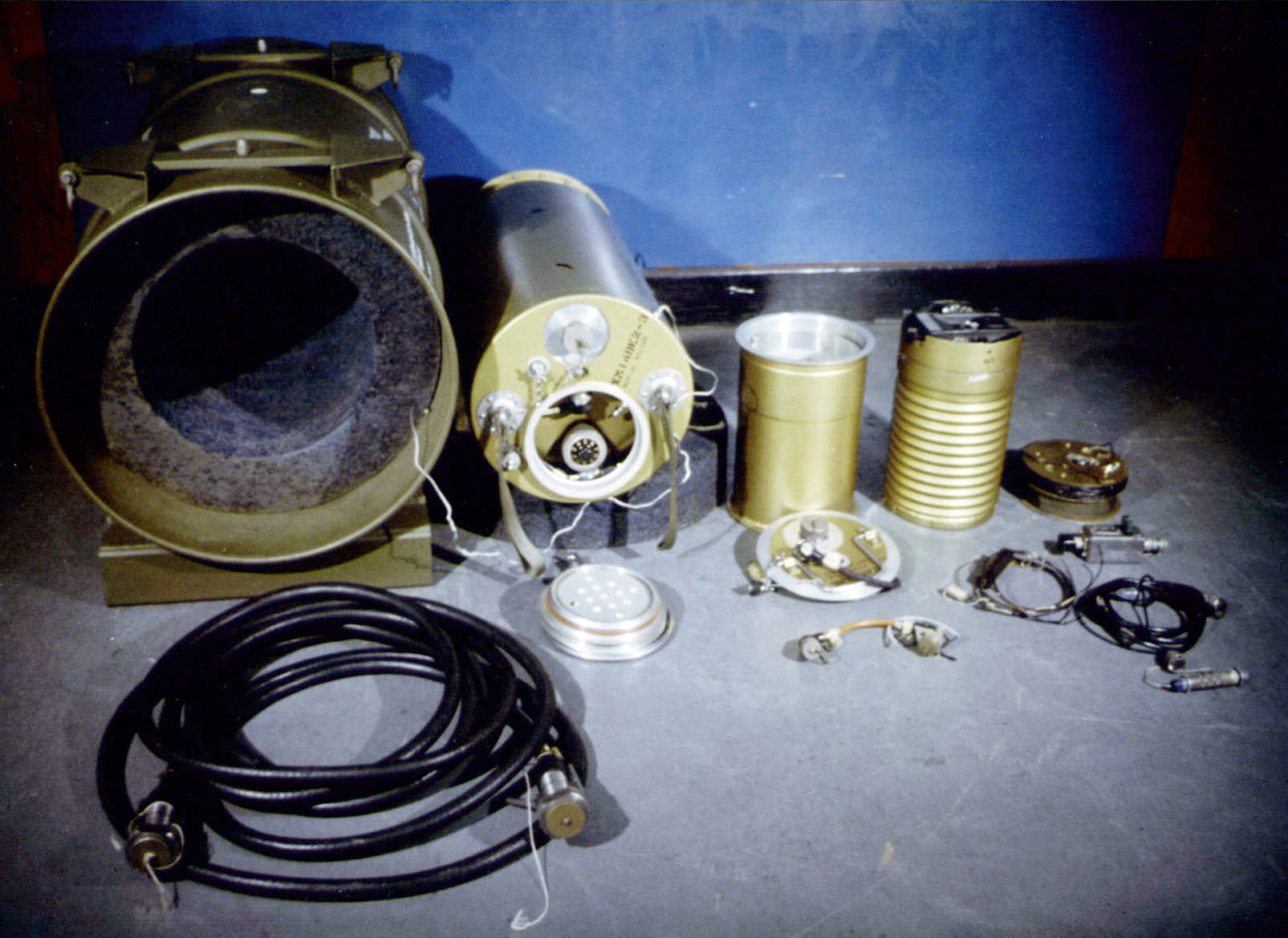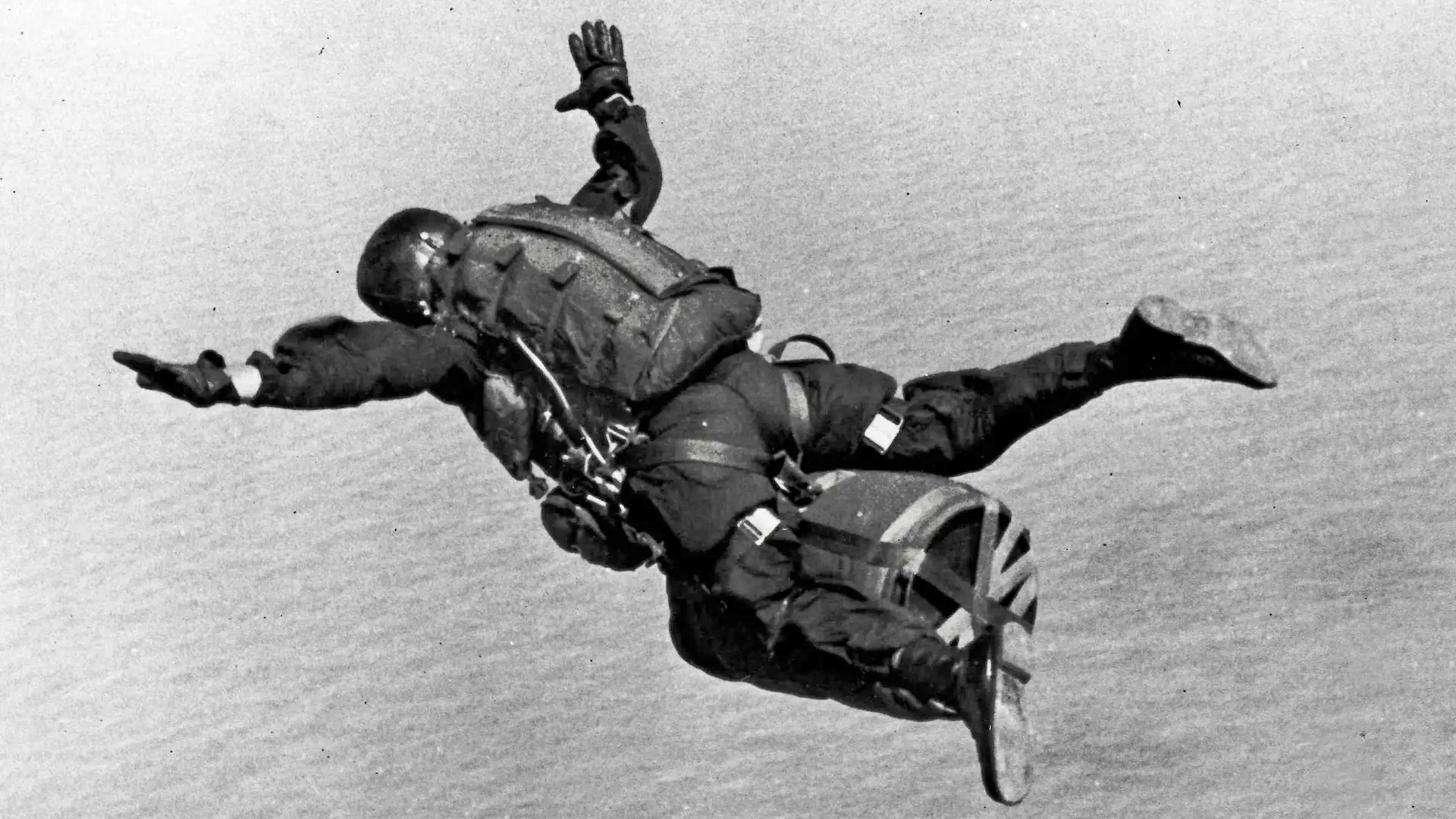For U.S. special operations personnel, conducting high-altitude parachute jumps are pretty much par for the course. Yet doing so with a nuclear bomb strapped between your legs is on an entirely different level.
That’s exactly what can be seen in the top shot above. Here, a U.S. Army Special Forces paratrooper is pictured free-falling during a training exercise with a Special Atomic Demolition Munition, or SADM, harnessed to them. A form of atomic demolition munition (ADM), SADMs were man-portable nuclear weapons, also known as “backpack nukes.” These munitions were fitted into specially designed hard/cloth carrying cases for their transportation on the backs (or between the legs) of special operators. SADMs weighed in the region of 150 pounds, with their warheads – the W-54/B-54 – contributing around 50-55 pounds. SADMs were extremely small, just 24 inches long by 16 inches wide.
But why did special operations personnel train with these munitions? In order to unpack this question, we need to look back to the 1950s and 1960s when the U.S. began to diversify its nuclear weapons capabilities.
The atomic blasts at Hiroshima and Nagasaki in August 1945 imparted a level of devastation never before seen in the history of human conflict. Just a few years later, the Soviet Union detonated its first atomic bomb in August 1949, codenamed “Joe-1” by the U.S. While the U.S. military conducted further tests of such weapons into the early part of the Cold War, a broader view emerged that smaller nuclear weapons for limited tactical purposes would likely prove critical for operations on the ground in future conflicts.

Indeed, the idea of using tactical nuclear weapons in a possible conflict involving the Soviet Union became an important component of President Dwight D. Eisenhower’s ‘New Look’ policy during the early to mid 1950s and into the early 1960s. As such, scientists and technicians at the Los Alamos and Sandia nuclear weapons laboratories began miniaturizing the size of the warheads used in nuclear weapons.
At the same time, the U.S. Army was making moves to acquire different sorts of battlefield nuclear weapons, including short-range ballistic missiles and the infamous M28/M29 Davy Crockett recoilless gun which fired nuclear warheads with a yield of roughly 10-20 tons of TNT. Part of the push towards fielding a broader range of nuclear weapons by the Army also included the development of atomic demolition munitions (ADMs).

ADMs were designed to be used on or below the ground’s surface (or even underwater) against specific targets to block and deny enemy forces. The initial objective of ADMs was to manage nuclear landscaping – creating giant craters or destroying mountainsides that could obstruct enemy forces. It was envisaged that small teams of engineers or special operations forces would carry and operate ADMs.
The munitions first entered the U.S. Army’s nuclear arsenal in 1954, with one of the first ADM tests taking place during Operation Teapot (1955), part of a series of nuclear tests conducted at the Nevada Test Site. During said test, an 8,000 pound ADM bomb with a yield of 1.2 kilotons was detonated, creating a crater 300 feet wide and 128 feet deep.
Into the 1960s, a whole family of ADMs was developed. This included the Tactical Atomic Demolition Munition (TADM), sporting a W-30 warhead. TADMs weighed around 840 pounds as a complete system, and around 300 were produced between 1961-1966. Medium Atomic Demolition Munitions (MADM) were also developed. Sporting the W-45 warhead, each weighed around 400 pounds. 350 MADMs were produced between 1962-1966. The warhead on both TADM and MADM munitions could be customized for various yields.

Desiring a much lighter, man-portable ADM, the Army ended up producing around 300 SADMs between 1964-1966. Production on an interim W-54 Mod 0 weapon started in April 1963, while the W-54 Mod 1 SADM was placed into production in August 1964. The Mod 1 SADM constituted the warhead, a fuzing/firing system, a mechanical timer, a ferroelectric firing set and its sealed housing. Later, the W-54 Mod 2 SADM was put into production in June 1965. At least two different SADM designs, the XM129 and XM159, were created.


At the heart of the SADM system was the W-54 tactical nuclear warhead. The W-54 was developed in the late 1950s – initially by Lawrence Livermore National Laboratory until early 1959 (designated the XXW-51), and, thereafter, by the Los Alamos National Laboratory (then re-designated the XW-54). The W-54 warhead measured just 16 inches in length and 10.75 inches in diameter. The yield of W-54 warheads was variable, from ten tons of explosive TNT to 1,000 tons of explosive TNT.

Compared to heavier ADMs, the Army envisaged that light weight SADMs could more easily be used tactically for operations behind enemy lines in Eastern Europe. In this sense, the munitions would be used to frustrate enemy forces by blowing up fortified structures, tunnels, mountain passes, and viaducts. Alongside their deployment via land or sea, SADMs were also designed to be sent behind enemy lines from the air. Two-man parachute teams – one individual carrying the disassembled weapon in a bag made of canvas – would descend to target points before setting up the device’s explosive timer. Owing to the U.S.’s nuclear doctrine dictating that no single person ever have the means to employ a nuclear weapon on their own, teams of at least two would accompany the bomb (with just one individual carrying it). The detonation code would be split between the two special operators, with both halves needed to start the weapon’s countdown.
The idea of using Special Forces teams, known as “Green Light” units, to transport ADMs behind enemy lines had roots stretching back to 1956. Indeed, using special operations units to harass and frustrate the enemy using ADMs chimes with the historical origins of the Army’s Special Forces in the early 1950s. It was envisaged that these elite units would ‘stay behind’ in rear areas to target enemy forces and even mobilize local resistance against them. However, early ADMs – such as the ADM-4 – were too large and heavy to be carried by one or two men. The production of SADMs moved the concept along quickly.
To be selected for the Green Lights was a rare and highly secret thing. As Annie Jacobsen notes in her book, Surprise, Kill, Vanish: The Secret History of CIA Paramilitary Armies, Operators, and Assassins, Green Lights personnel were pulled from Army Special Forces, Navy SEAL units, and the Marines. Units worked under pseudonyms, and wore fatigues with no markings or insignia. Initial training involved learning infiltration techniques including parachute launches and wet-deck submarine launches. Overall, the instruction of Green Light units took place over the course of a week, consisting of eight to 12 hours each day.
Parachute missions involving SADMs were performed over the sea, as well as over land during the 1960s and 1970s, in order to train for their potential detonation overseas. In 1972, Green Light units parachuted near the White Mountain National Forest in New Hampshire. As Foreign Policy notes, the nuclear weapon used was a training dummy. Navy SEALs also performed underwater training with the munitions. Moreover, drills with the SADMs also occurred outside the U.S., with Special Forces teams even skiing with them in the Bavarian Alps during, for example.

“Timing was everything” when it came to parachuting from planes with nuclear weapons, Billy Waugh recalls of his time with the Green Lights in Surprise, Kill, Vanish. “You had to jump quickly – you couldn’t afford to be spread out when you landed on the ground.” Indeed, the jumper’s rigging was designed in such a way that the nuclear component would fall to the end of a 17-foot-long lowering line once outside of the aircraft.

Once SADMs were fixed in place, and their detonation charges triggered, Green Light personnel needed to retreat to a ‘safe’ location to avoid being caught in the explosion. This would have been a difficult task given that the timers could not be relied on for complete accuracy. As Army field manuals from the time indicated, it was “not possible to state that [SADM timers] will fire at a specific time.”
Furthermore, there was also the fact that Green Light teams would also have had to make their way out of enemy territory once the munition was detonated. According to Bill Flavin, who commanded a Special Forces SADM team during the Cold War, “there were real issues with the operational wisdom of the program, and those who were to conduct the mission were sure that whomever thought this up was using bad hemp.” Indeed, many special operators accordingly described the work of Green Light teams as suicide missions.
As SADMs were never used on foreign soil during the Cold War, those realities were, thankfully, never realized. That the U.S. military was training Special Forces personnel to personally transport nuclear weapons behind enemy lines gained wider traction publicly in 1984. Ex-Army intelligence officer William Arkin and colleagues presented sketches and descriptions of the SADM to the Natural Resources Defense Council, with the revelations reverberating within Congress and among the public. From there, the weapon was slowly phased out, and was officially retired in 1989.
So there you have it, the crazy history behind the U.S. military’s SADMs. The next time you think that your job is stressful, just remember you don’t have a nuclear bomb literally strapped to you as you jump out of a perfectly good airplane.
Contact the author: oliver@thewarzone.com
